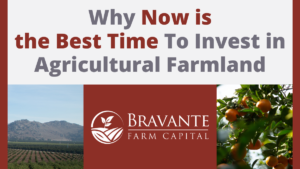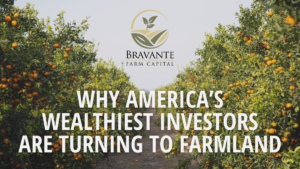The Tax Benefits of Farmland Investing
Introduction
Despite the amount of farmland across the country, it rarely draws the attention of the top commercial real estate investors. However, as cap rates among other CRE sectors remain considerably lower than farmland real estate, more are starting to look at farmland investments. Just recently, Bill Gates spent $13.5 million to acquire a 2,100-acre potato farm in North Dakota.
A growing number of investors, like Bill Gates, have come to realize that the sector has incredibly strong underlying fundamentals: the global population is growing, demand for farmland is increasing, and yet there is only so much arable land available to cultivate. This is driving values up, making farmland more profitable than ever before.
One of the reasons why farmland is such a good investment option relates to the tax benefits associated with ownership. In this article, we look at the tax-saving strategies that farmland owners can employ to maximize returns on their investment.
Learn more about our investment strategy and join the waitlist for our next opportunity.
Top 7 Tax Benefits Associated with Farmland Investments
1. Depreciation
One of the ways the federal government encourages people to support the economy is by offering tax benefits associated with investing in businesses. Real estate investments are categorized as such. Real estate, like other business assets, can be “depreciated” to account for the normal wear and tear on a property as well as its functional obsolescence. Using straight-line depreciation, owners can write off those expenses over a 27.5-year lifespan (residential) or 39-year period (commercial).
Most people assume that farmland is ineligible for depreciation because land, on its own, is not considered a depreciable asset.
However, any land improvements – from actual vineyards and orchards and irrigation systems to parking lots, fences, and associated building structures – are depreciable.
The farmland owner (or syndicate’s general partner) can use what is known as a cost segregation study to assign a useful life to each of those property elements. Rather than using straight-line depreciation, they can then accelerate depreciation based on the true life of that individual asset. For example, trees in an orange grove typically have a 10-year lifespan, so these can be depreciated over a shorter period of time.
2. Bonus Depreciation
Through at least the remainder of 2022, farmland is eligible for bonus depreciation. Think of bonus depreciation as extremely accelerated depreciation: 100% of eligible expenses can be depreciated in the first year the farm has been placed in service.
The impact of bonus depreciation is that it puts more money back in investors’ pockets sooner. Rather than claiming those passive losses over time, they can be applied to other passive income today to offset those tax burdens.
While it is true that bonus depreciation may be phased out and/or eliminated in the years to come, even if that happens, farmland is poised to reap greater benefits from depreciation than other CRE asset classes.
This is because most elements of commercial property – a roof, for example – have longer lifespans than most farmland depreciable assets. Whereas maybe 30% of a commercial property could be depreciated in ten years or less, upwards of two-thirds of farmland assets can be depreciated in that time. Only agricultural buildings, like a packing house, have longer lifespans but even these tend to be depreciable in 20 years vs. 27.5 or 39 years like other CRE assets.
3. Write-Off of “True” Losses
Depreciation is what’s referred to as a “paper loss”. A farm can still be generating a profit while simultaneously taking depreciation, which creates passive losses for investors. However, there are some instances in which farms will generate true losses.
For example, there may be a year in which an extreme weather event destroys the entire crop and therefore, the farm is not profitable. An extreme frost, for instance, could damage an entire crop essentially overnight. While this can makes some investors apprehensive about investing in farmland there are two important caveats for these situations:
One, the value of these “true” losses can also be used to offset other passive income, just as you would do with any other business losses. And two, here at Bravante we carry substantial insurance to mitigate against risks like these and in many instances can end up making more money with insurance payouts than had the crop come in as planned.
5. Tax Deductions
Just as a multifamily owner or operator would write off the cost of certain supplies, repairs and maintenance, farmland operators can claim similar tax deductions. For example, a ranch operator can deduct the cost of tools, fuel for their equipment, seeds, plants, fertilizer, and other routine expenses that are needed for the farm to function.
Similarly, farmers can write off property repairs and maintenance. For example, if the roof on a packing facility needs to be replaced, the costs of doing this can be written off in the year that cost was incurred.
6. 1031 Exchanges
Farmland, like other types of commercial property, is considered 1031-exchange eligible. Under current IRS guidelines, someone can sell their farmland investment and roll the proceeds into a like-kind asset (including farmland but also other commercial real estate). Doing so will allow them to defer paying capital gains tax – a substantial cost savings, especially with farmland values appreciating so dramatically in value.
Of note, individuals can also sell their existing investment property and roll those proceeds into farmland using a 1031-exchange. This becomes a great tool for those looking to diversify their real estate portfolios by adding farmland to the mix.
7. Property Tax Benefits
Farmland tends to benefit from favorable property tax rates, as well. While the actual property tax rate is set by the local municipality, and therefore will vary from one place to another, property taxes on farmland (agricultural land) are generally lower than the property tax rate applied to either residential or commercial property.
Tax Benefits for Farmland Development
When an investor purchases farmland for development, there is what is referred to as a “pre-production” period – i.e., the time it takes to get the farm up and running. This could include the time it takes to install irrigation systems, windmills, packing facilities and more. It also refers to the time it takes for the crops to grow and become productive. For example, if starting with raw land, it usually takes about four years to plant citrus groves before those groves can be harvested.
Depending on the crop, the pre-production period can be anywhere from two years (e.g., almonds) to 8-10 years (e.g., pistachios).
Any costs incurred during the pre-production period must be categorized as capital expenses and therefore, cannot be depreciated until the farm is “placed in service.” A farm is considered placed in service during the year of the first harvest, whenever that may be. Until then, there is very little eligible for depreciation.
Tax Benefits for In-Service Farmland
If a farm is already in service, meaning that it is already producing crops for sale, then depreciation kicks in right away. Let us assume that the farmland is worth 20% of the farm’s value. That leaves 80% of the value that can be depreciated starting from Day 1. As long as bonus depreciation remains in effect, those losses can all be claimed immediately.
Limited partners who have significant passive income, from farmland investments or otherwise, these passive losses are particularly beneficial. The tax savings they earn in Year 1 can be used to recoup a portion of their initial investment in that farmland.
How Passive Losses Get Passed on to Farmland Investors
Unless the farmland is part of a publicly traded partnership (which does not apply to most farmland syndicates), then passive losses can be passed through on a pro rata basis to individual limited partners. In fact, in a syndicate, any losses in excess of 35% must be passed on to limited partners. Then, when it is time for LP investors to file their taxes, they will report these losses on their K-1 form.
These losses can then be used to offset any other passive income – regardless of where that passive income comes from.
Let us say that a farmland syndicate generates $10,000 in passive losses in Year 1 for each of its passive investors. An investor who also owns a multifamily property, for example, can use the $10,000 in losses to offset up to $10,000 in passive income generated from that rental property. For those who do not have any other sources of passive income, these losses can be carried forward (or carried backward) to be applied to passive income at a later date.
To be clear: passive losses can only be used to offset passive income. Someone who only invests in farmland cannot, for example, use those losses to offset their regular salaries or other W2 income.
Conclusion
As you can see, farmland benefits from many of the same tax benefits associated with other commercial real estate. The most significant benefit, though, is that farmland’s relative depreciable life is significantly shorter than either commercial or residential property. This creates more passive losses for investors sooner than if they were to invest in multifamily or other more traditional CRE assets.
These tax benefits should not be overlooked. Investing in farmland can be highly profitable given its current values and productive capacity. These tax benefits magnify the returns an investor can expect to earn by investing in a farmland syndicate alongside an experienced, business-minded sponsor.
Learn more about our investment strategy and join the waitlist for our next opportunity.



